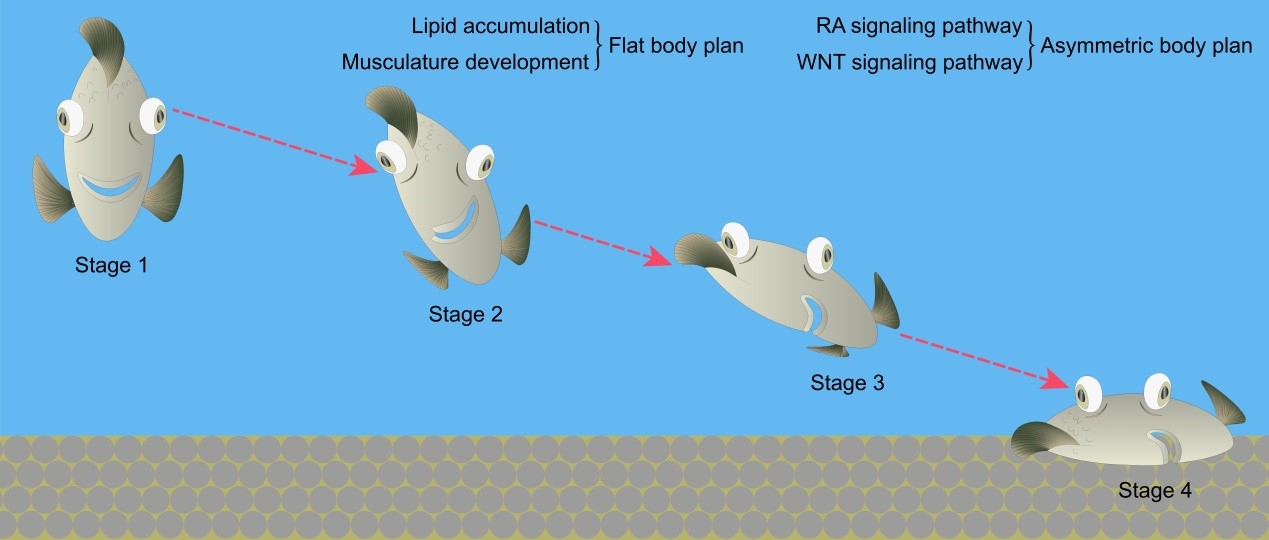Flatfishes have evolved one of the most specialized and unique body plans (flat and asymmetry) among the teleosts. However, the origin and formation mechanism of the peculiar morphology of flatfishes remain unknown.
A research team formed by Chinese Academy of Sciences (Kunming Institute of Zoology, South China Sea Institute of Oceanology, and Institute of Hydrobiology), Zhejiang Ocean University and Northwestern Polytechnical University, has unraveled the evolutionary and genetic origins of the specialized body plan of flatfish through comparative genomic analyses. The finding was published in Nature Genetics on April 19, 2021.
By combining ten de novo-assembled genomes in this study with eight already published genome sequences from teleost species, researchers found that Pleuronectoidei and Psettodoidei do not form a monophyletic group, indicating independent origins from different percoid ancestors.
Researchers found that several genes related to visual perception, immune response, hypoxia tolerance, and cardiac function have occurred significant alteration, possibly suggesting a similar remodeling of their visual, immune, respiratory and circulatory systems in benthic adaptation to seafloor colonization.
Genes associated with musculature development and lipid accumulation have occurred marked changes in flatfishes. Experiments on one flatfish fat-related genes found fast lipid oxidization and decreased fat accumulation in flatfish and thus may correlate with the evolutionary origin and development of their flat body plan.
Besides, the researchers found that multiple genes from WNT and RA signal pathways which have key roles in normal body axis development have undergone remarkable genetic alterations in flatfishes, suggesting their roles in the evolution of asymmetric body plan.
Using Paralichthys olivaceus as a representative species, researchers found that multiple genes in both RA and WNT signaling pathways exhibited obvious transient expression fluctuations during metamorphosis, with marked left–right asymmetrical expression initiating from the premetamorphic stage, climbing to an asymmetrical climax during the prometamorphic and metamorphic climax stage and then recovering to symmetry in the post metamorphic stage. These analyses provide gene evolution and expression evidence for the possible involvement of WNT combined with RA signaling pathways in shaping the asymmetric body plan in flatfishes.
The findings have substantially clarified the long-standing controversies over the phylogeny of flatfishes, while the genes highlighted in this study lay a blueprint for future functional characterization of the molecular mechanisms underlying the unusual body plan of flatfishes.
This study, entitled “Large-scale sequencing of flatfish genomes provides insights into the polyphyletic origin of their specialized body plan”, was published in Nature Genetics on April 19, 2021. Web link: https://www.nature.com/articles/s41588-021-00836-9.
Dr. LI Yongxin, Dr. KONG Xiaoyu and Dr. WANG Wen are the co-corresponding authors, and Dr. Lü Zhenming, Dr. GONG Li, Dr. REN Yandong, Dr. CHEN Yongjiu, Dr. WANG Zhongkai, Dr. LIU Liqin, and Dr. LI Haorong are the co-first authors in this paper. Researchers in the Center for Excellence in Animal Evolution and Genetics, Chinese Academy of Sciences participated in this study. This study was financially supported by grants from the Open Fund of the State Key Laboratory of Genetic Resources and Evolution (Kunming Institute of Zoology, Chinese Academy of Sciences), Introduction of Talent of Zhejiang Ocean University, and the National Natural Science Foundation of China.

The metamorphosis process of flatfishes (Image designed and drawn by Dr. LI Yongxin, copyright preserved).
(By LI Yongxin, Editor: YANG Yingrun)
Contact:
YANG Yingrun
yangyingrun@mail.kiz.ac.cn
